 |
||
|
||
| ||
 I think that the period starting 6 years ago with the first 3D accelerators is not that big so that the teenagers do not know anything from the 3D history. However, I met some students specializing in computer engineering who had no idea about Riva128, RAGE II, Voodoo Rush etc. But most readers interested in 3D or in the history of the videocard
development (not necessarily 3D) will certainly feel nostalgic seeing...
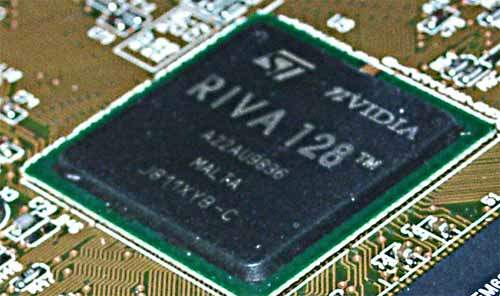 The very Riva128 card that saved NVIDIA from death after its failure with
the NV1.
 Intel's first attempt to try itself in 3D graphics after the purchase of Chip & Technologies. I remember our editor saying in the beginning of 1998 that Intel would
soon stomp the Riva into the ground with its new much more powerful product...
However, the reality was not so bright.
 April 1998. The effective advent of the powerful accelerator! CDs with games marked with the 3Dfx's logo. The price of $350 for a 12MB card making users sigh deeply... And envy... at Comtek'98 (here are some photos from there):
 So, where is Creative located? I give you one minute to think, otherwise you
won't get the souvenir!  The fastest 2D performer before the advent of the Matrox solutions - ATI Mach64... These cards were very pricey at that time, over $350 for the 4MB card.
 The 2D king in speed and quality - Matrox MGA. Although this is the Millennium II chip depicted, the first MGA1 look
exactly the same. In spite of all ATI's efforts to keep prices, Matrox
damaged their plans completely... $500 for the Millennium1 in the beginning
of the sales. How carefully users were keeping the boxes with such cards
in their hands!
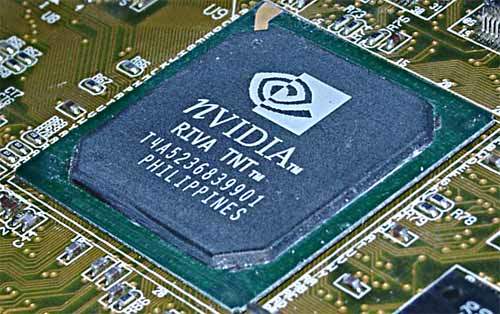 The 3D leader for the autumn of 1998. This was a kind of trinitrotoluene for 3D enthusiasts. Although it was a very difficult situation in Russia at that time, RivaTNT managed to gain the popularity there. Nostalgia... This is only a part of what I can speak of for hours. But let's get back on the track. Not so long ago we tested a great number of 3D accelerators from the latest models to those released in 1998. We were to find out whether old video cards were compatible with the modern AGP 3.0 mainboards, as well as to compare the speeds in three tests (with the highest 3D quality). Today we will run a great number of cards on the old platform based on the Pentium II 350 MHz (i440BX) in order:
So, let's start with the participants. They will be introduced in the chronological order like the last time. There is nothing to comment on much, especially because the "stars" are marked with the "shine" coming from a given processor. 1997
Voodoo Graphics 4MB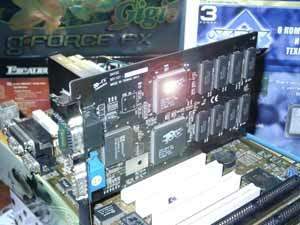 It was an idol of the end of 1997. Sky3D's card. 1998
i740 4MB Diamond Multimedia's card. NVIDIA Riva 128 4MB STB's card. 3dfx Voodoo2 SLI 24MB The dual accelerator goes on the Quantum3D's card - Obsidian2 X-24. NVIDIA RivaTNT 16MB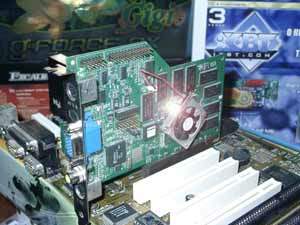 Canopus's card. SIS 6326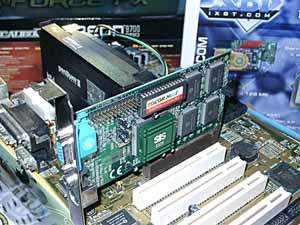 LuckyStar's card. It wasn't much popular because of the buggy 2D. Its 3D quality wasn't shining either. 1999
NVIDIA RivaTNT2 M64 32MB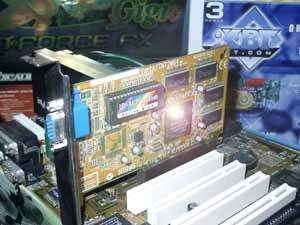 MSI's card. NVIDIA RivaTNT2 Ultra 32MB Hercules's card. The last of the Mohicans ... of old Hercules. 3dfx Voodoo3 16MB The flagship of the Voodoo3 line - Voodoo3 3500TV 3dfx Velocity100 8MB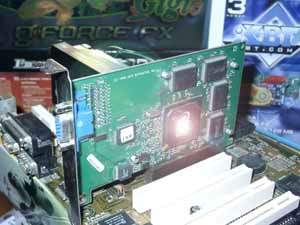 S3 Savage4 32MB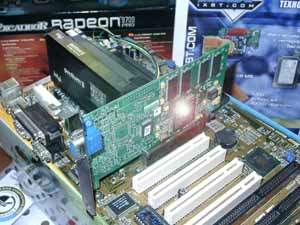 Diamond Multimedia's card. Matrox G400 32MB Matrox's card. ATI RAGE 128 PRO 32MB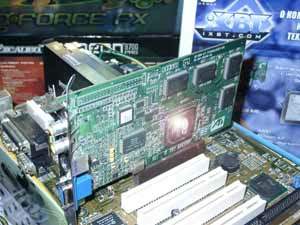 At that time the Canadian company made the cards itself. S3 Savage 2000 32MB The launch of this chip was marked with the purchase of Diamond Multimedia by S3, that is why it's easy to guess that this card was from DM. 2000
NVIDIA GeForce2 GTS 32MB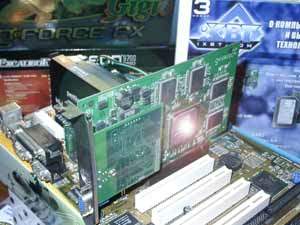 AOpen's card. NVIDIA GeForce2 Pro 64MB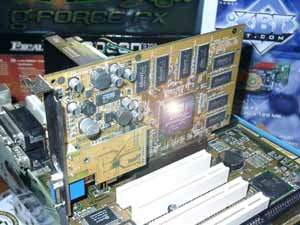 Chaintech's card. NVIDIA GeForce2 MX200 32MB Gigabyte's card. NVIDIA GeForce2 MX400 32MB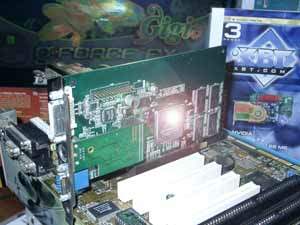 NVIDIA's reference card built on the GeForce2 MX; in the tests it was overclocked up to the clock speeds of the MX400 - 200/183 MHz. 3dfx Voodoo4 4500 32MB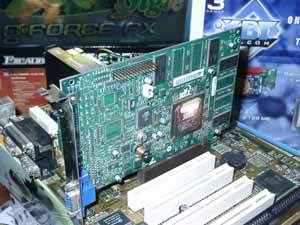 3dfx Voodoo5 5500 64MB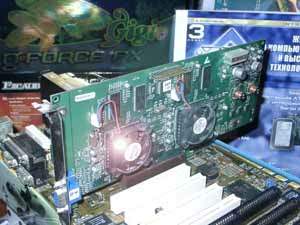 ATI RADEON 32MB SDR ATI's card. ATI RADEON 64MB DDR ATI's card. SIS 315 128MB Joytech's card. PowerVR/STM KYRO 32MB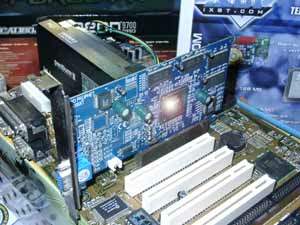 Hercules's card. 2001
NVIDIA GeForce3 64MB Reference card from NVIDIA. NVIDIA GeForce3 Ti200 64MB ABIT's card. PowerVR/STM KYRO II 32/64MB Hercules's card. Matrox G550 32MB DDR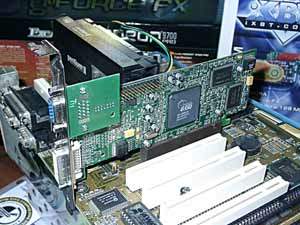 This new old product tops the Matrox's card. This is actually a 2D card, its 3D mode was very weak for 2001, and the card failed to become a 3D star. ATI RADEON 7500LE 64MB DDR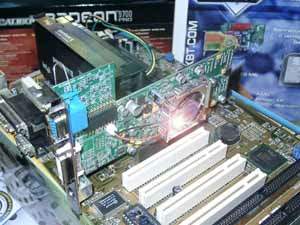 Jetway's card. ATI RADEON 7500 64MB DDR ATI's card. ATI RADEON 8500 128MB DDR 3.6ns (275/550 MHz)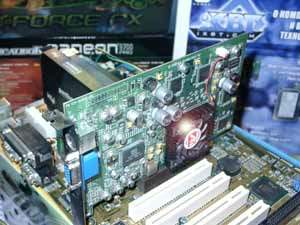 ATI's card. 2002
Trident Blade XP 32MB HIS's card. Its low speed and buggy drivers didn't let this card gain any popularity. S3 Savage XP 32MB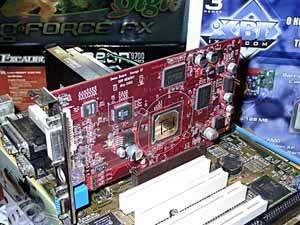 This is a demo card, i.e. a video card on the early silicon, that is why the T&L, for example, does not work there. Production of such cards wasn't even started. PowerVR/STM KYRO II SE 64MB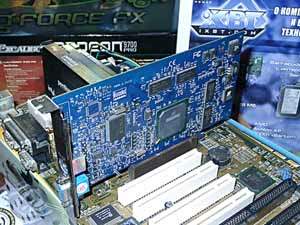 Hercules's card. This card is actually dead too. NVIDIA GeForce4 MX 440 64MB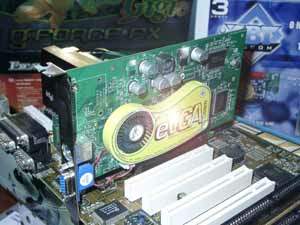 eVGA's card. NVIDIA GeForce4 MX 440-8x 64MB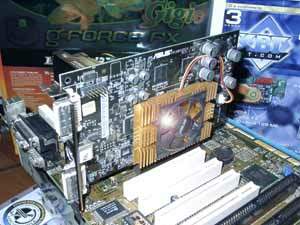 ASUSTeK's card, the clock speeds are set by default - 275/513 MHz. NVIDIA GeForce4 MX 440-8x 64MB GS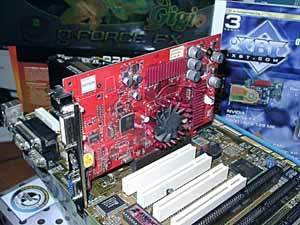 Gainward's card; it works at the higher frequencies of 300/600 MHz, but the price, being too high, stood on the way of its popularity. NVIDIA GeForce4 MX 440-8x 128MB Prolink's card. 128 MB on such cards is not needed. NVIDIA GeForce4 Ti 4200 64MB (250/500 MHz) Triplex's card. NVIDIA GeForce4 Ti 4200 128MB (250/550 MHz)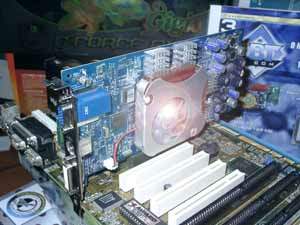 The famous card from Albatron NVIDIA GeForce4 Ti 4200-8x 128MB (250/513 MHz) NVIDIA's reference card. NVIDIA GeForce4 Ti 4200-8x 128MB (275/550 MHz) ABIT's card. Probably, such cooler gave NVIDIA the idea of FlowFX with its terrible noise. NVIDIA GeForce4 Ti 4600 Albatron's card. ATI RADEON 9000 64MB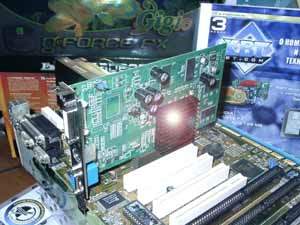 Sapphire's card. ATI RADEON 9000 PRO 64MB Hercules's card. ATI RADEON 9100 64MB This is actually the very RADEON 8500LE, just renamed into 9100, that is why its processor is "shining" here, - the RADEON 8500LE was very popular. ATI's card. ATI RADEON 9100 128MB This is a new old product: the chip is the same 8500LE, but the memory used is different. The former RADEON 8500LE with 128MB memory was completed with the BGA memory. Now we have old chips in the TSOP package. PowerColor's card. ATI RADEON 9500 64MB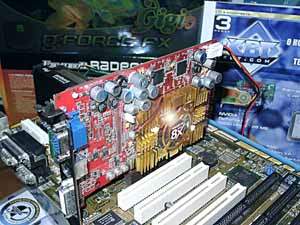 Gigabyte's card. ATI RADEON 9500 128MB (256bit) The most popular Sapphire's product; it has a 256bit card and, therefore, can be redesigned into the RADEON 9700. ATI RADEON 9500 128MB (128bit)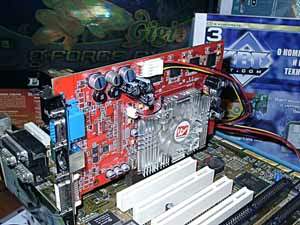 HIS's card. ATI RADEON 9500 PRO 128MB Hercules's card. ATI RADEON 9700 PRO 128MB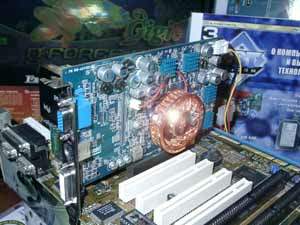 Hercules's card. ATI RADEON 9700 128MB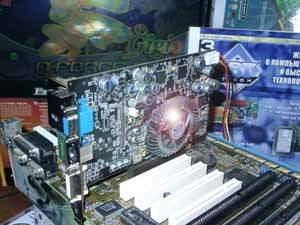 Sapphire's card. SIS Xabre400 64MB Gigabyte's card. SIS Xabre400 128MB Joytech's card (128MB is not needed at all here). SIS Xabre600 64MB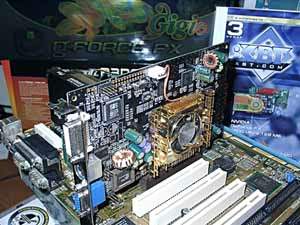 SIS Reference card. The card is expensive, but it makes no sense... 2003
ATI RADEON 9200 128MB The same RADEON 9000 just with the AGP 8x support. Gigabyte's card. NVIDIA GeForce FX 5800 Ultra 128MB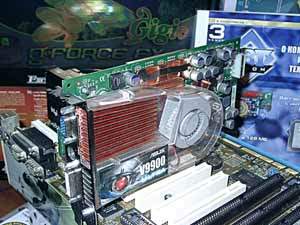 ASUSTeK's card. NVIDIA GeForce FX 5600 Ultra 128MB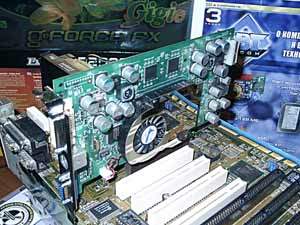 NVIDIA's reference card. NVIDIA GeForce FX 5200 Ultra 128MB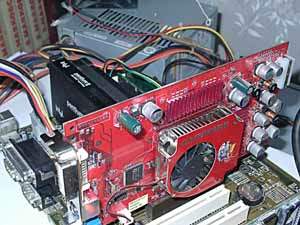 Gainward's card. NVIDIA GeForce FX 5200 128MB (250/400 MHz) Leadtek's card. NVIDIA GeForce FX 5200 128MB (250/300 MHz)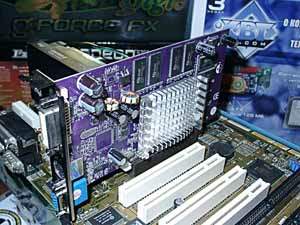 Palit's card. ATI RADEON 9800 PRO 128MB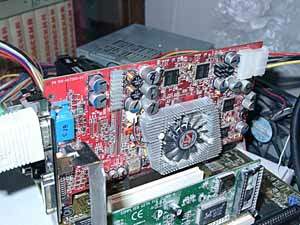 The fastest card for today. ATI's Reference card. TestsTestbed:
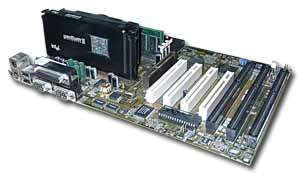 VSync off in the drivers, texture compression off (in games), texture detail set to High Quality. The Voodoo2 SLI, Voodoo3, Voodoo Graphics, Riva128, i740 cards are tested in the 16bit color, and the rest in the 32bit one. The Voodoo Graphics was tested in 640x480. Test applications:
      ConclusionThere are actually two things to be pointed out:
Note that such reviews are not going to be regular, i.e. you shouldn't
expect more test sessions like this one.
Andrew Worobiew (anvakams@ixbt.com)
Write a comment below. No registration needed!
|
Platform · Video · Multimedia · Mobile · Other || About us & Privacy policy · Twitter · Facebook Copyright © Byrds Research & Publishing, Ltd., 1997–2011. All rights reserved. |